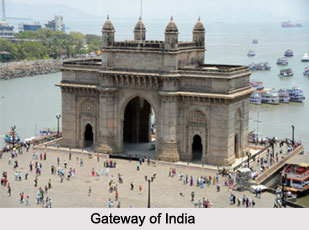 Mumbai is often referred to as the city of dreams. If one has the will to fulfil his or her aspirations then this city is theirs. It is said that Mumbai never sleeps. People work round the clock to accomplish their dreams. Almost every nook and corner of the city is dotted with fascinating rags to riches stories.
Mumbai is often referred to as the city of dreams. If one has the will to fulfil his or her aspirations then this city is theirs. It is said that Mumbai never sleeps. People work round the clock to accomplish their dreams. Almost every nook and corner of the city is dotted with fascinating rags to riches stories.
The chic look of the city often makes visitors forget the fact that they are standing on a metropolis that was formed by merging 7 islands. Formerly this capital city of Maharashtra was known as Bombay but today its name has been changed to Mumbai. It, probably, has its origin in the regional deity, Mumba Devi, who is worshipped by the fishing community in the Mumba Devi Temple. Besides being the commercial capital of India, Mumbai is home of the wealthy and the glamorous. It has long been India`s favourite film industry (Bollywood Film Industry) that produces more films each year than any other city in the world. Nowadays it is also the home to India`s satellite and television industries.
The Afghan Memorial Church of St. John the Evangelist is located in the Colaba area. The church was established in 1847 and was consecrated 11 years later as a memorial to those who died in the First Afghan War. This is an interesting piece of architecture with Gothic arches and stained-glass windows.
When a tourist comes to go to the pilgrimage destinations in Mumbai or Bombay, the first place that comes to mind is the Siddhi Vinayak Temple at Prabhadevi. Usually in most religious depictions, the elephant headed Lord Ganesha also known as Ganpati in Maharashtra has his trunk curled to his left. But in this temple, he is depicted with his trunk pointing to the right. He stands strong with four arms, one bearing a lotus, the other an axe, the third a Modak, a traditional Indian sweet which Ganpati is said to have a weakness for and in the fourth a garland of beads. He is flanked on either side by his two wives Riddhi or Siddhi. The temple is the most crowded during Angaraki and Sankashti Chaturthi days that is Ganesh Chaturthi, which are considered holy days according to the Hindu calendar.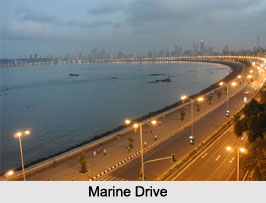
Mumbai Haji Ali - An integral part of the multicultural and multi ethnic diversity of Mumbai, Haji Ali Mosque is one of the major pilgrimage spots in Mumbai. Not surprisingly there are as many Hindus as there are Muslims that visit the mosque for wish fulfilment. The mosque is built in the middle of the sea with a narrow strip of land leading to it. It set about 500 yards into the Arabian Sea, it can be reached only at low tide. According to folklore, Haji Ali was a wealthy businessman who died on a pilgrimage to Mecca. It is said that the casket carrying his body floated all the way back to the site where the mosque now stands. This mosque was built in 19th century. The mosque gives the impression that it is floating on the sea, especially during high tide. As per Islamic laws there are separate prayer rooms for men and women. Throngs of people come to bow their heads on the red and green brocade sheet covering the tomb and pray for the realization of their dreams.
Shirdi Baba Temple- Shirdi Baba Temple is located about 296 kilometres from Mumbai. Shirdi Temple is a popular pilgrimage destination for the followers of Shirdi Sai Baba. The headquarters of the Shri Sai Baba Sansthan are located here. The Sansthan does a lot of welfare work including having built a Sai Baba Bhakti Niwas to accommodate about 3500 devotees, a Shri Sainath Hospital which is well equipped with the latest equipment and provides free treatment and a Prasadalaya which provides hygienic divine food or "Prasada" to 1000 devotees at a time.
The nearest railway station which connects Shirdi is Korpargaon, 15 kilometres on the Manmad-Daund section of the Central Railways.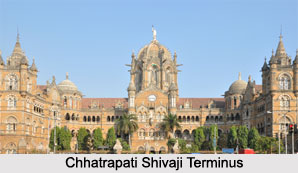
Fairs also take place on a large scale in Mumbai to commemorate religious festivals. One such event is the Bandra Fair or Virgin Mary Feast that is celebrated to mark the feast of St Mary. It is centred on an image of St Mary at the Mount Mary Shrine and attracts thousands of seekers of succour and favours - with no particular distinction of caste or creed.
Nature Tourism in Mumbai
One of the most amazing sites in Mumbai is presented by its gardens and parks. It is dotted with parks and gardens. It is wonderful to notice that alongside skyscrapers and elevated edifices there are a number of lush green parks and gardens that provide breathing spaces to this capital city of Maharashtra.
The parks and gardens in Mumbai are as follows: -
Sanjay Gandhi National Park: this is considered to be the largest park in the world that is located here. Formerly it was called the Borivali National Park.
Besides there are Victoria Gardens, Kamala Nehru Park, Horniman Circle Gardens and Hanging Gardens which are worth a visit. There is also the Flora Fountain that is situated in Hutatma Chowk. It was erected in the honour of the Governor, Sir Henry Bartle Edward Frere, who built new Bombay in the 1860s.
Leisure Tourism in Mumbai
The tourists will have a lot of places of interest to check out. One can start with the Fort area in South Bombay. It derives its name from the fact that the area fell within the former walled city. Today, however it is a beautiful heap of ruins and a small fragment of it survives as part of the eastern boundary wall of St. George`s Hospital. Memories of this walled area were preserved in such names as Church Gate, Bazaar gate and Rampart Row.
The Gateway of India is located on the waterfront at Apollo Bunder. It was conceived as a triumphal arch to commemorate the visit of George V and Queen Mary for the Delhi Durbar in 1911. The honey-coloured basalt of the arch faces the sea and as the light of the rising and setting sun falls on it the colour changes from shades of gold to orange and pink.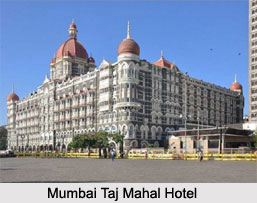
One of the most amazing tourist attractions in Mumbai is the island of Gharapuri or Elephanta. An hour`s drive by the motor launch will lead the tourists to the site of a magnificent series of rock-cut cave temples with large sculptured interiors. The main attraction here is the massive 18 feet three-headed bust of Lord Shiva, representing his manifestations as Creator, Preserver and Destroyer. The Portuguese called the island Elephanta after a massive elephant sculpture that once found in one of the excavated courtyards there. Today the statue has been shifted to the garden of Mumbai zoo.
The National Park consists of the 2nd-century Buddhist hill caves of Kanheri that is Kanheri Caves. This place is also famous for its sculptures.
The charm and beauty of the city is largely dependent on the beaches. Beyond the city centre there are the beaches of Juhu Beach, Versova Beach , Madh Island Beach , Marve, Manori and Gorai.
Marine Drive is one of the landmarks of Mumbai. It links Malabar Hill. This long curving road along the buttressed sea-coast provides wonderful panorama of Mumbai`s skyline at daytime and the glittering city at night. Along Marine Drive runs a wide sidewalk that is ideal for the early morning jogger, evening walker and late night stroller.
Chowpatti Beach is a great place to hangout for, it is located at the north end of Marine Drive. It is a stretch of the sandy beach. In the evenings, it is crowded with people enjoying the cool sea breeze and the delicious Bombay bhelpuri and other snacks. Chowpatti is famous also for its kulfi and ice creams. During the Ganesha Chaturthi festival, the idols of the lord are immersed in the sea here.
Besides this there is the Crawford Market that was designed by William Emerson. It has bass relief by J.L. Kipling.
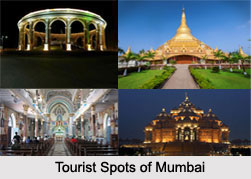 The finest example of Victorian Gothic structure in Bombay is Victoria Terminus. It is designed by Frederick William Stevens. The structure is made of yellow sandstone and granite. Both these materials are combined with polychromatic stones and blue-gray basalt for decorating the interiors.
The finest example of Victorian Gothic structure in Bombay is Victoria Terminus. It is designed by Frederick William Stevens. The structure is made of yellow sandstone and granite. Both these materials are combined with polychromatic stones and blue-gray basalt for decorating the interiors.
Besides these there is the Prince of Wales Museum. It preserves some excellent examples of Indian miniature painting of the Mughal and Rajasthan schools and artefacts of jade and chinaware.
Mumbai is a shopper`s paradise. From trendy apparels to fashion jewellery to antique pieces of art-almost everything is available in the markets of Mumbai. The city has always been famous for its textiles. Whether a person is looking for cotton, chiffon Sarees or silk Mumbai is the best place to shop for these materials. Apart from being priced reasonably the tourists will find an awesome collection of clothes. Latest cars, gizmos, leather items and trendy furniture are also available here. The Chor Bazaar is the perfect place to shop for antiques. For fashionable people there is the Fashion Street. Besides these market areas there are sprawling malls that adorn the heart of the city. Another place that the tourists cannot miss is the Zaveri Bazaar. In case the travellers are interested in golden jewellery then this will be just the right place for them to drop in.
Visiting information regarding Mumbai
Chhatrapati Shivaji International Airport, Mumbai, is India`s busiest airport and one of the main international gateways to the country. This airport has both domestic and international terminals. It is located at a distance of 28 kilometres from downtown. Prepaid taxis are available for the tourists. One can also avail bus services to Vile Parle Station and then travel by the local trains. Railways are also a favourable way of travelling to and from the city to the rest of the country. Mumbai has one of the finest natural harbours. Hence people can also reach this city by cruises from Dubai, Malaysia, Singapore and others. There are 3 railway lines that serve the city. The Central line, the Western line and the Konkan Railway are the three railway lines. The railway stations are Chattrapati Shivaji Terminus, Dadar Terminus, Lokamanya Tilak Terminus, Mumbai Central and Bandra.
Mumbai summers are hot and humid while the winters cool. The sea breeze brings relief throughout the year. The monsoon that hits the coast between June and September brings heavy rain. The best time to visit Mumbai is from October to February. Local transports are also available easily to tour the city.
It would not be wrong at all to term Mumbai as the melting pot of India. It is home to all Indian creeds and cultures. An amalgamation of culture is quite apparent in this city. It is probably for this factor that the trip to Mumbai becomes all the more arresting.



















